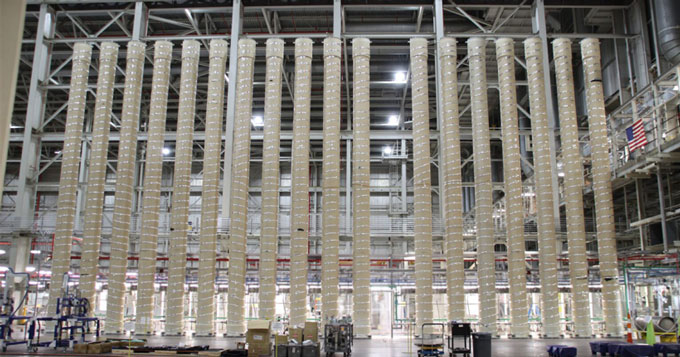Extreme Climate Survey
Scientific news is collecting questions from readers about how to navigate our planet’s changing climate.
What do you want to know about extreme heat and how it can lead to extreme weather events?
But some scientists are raising concerns about HALEU’s growth. According to a June 7 comment ScienceHALEU could be used to make a nuclear weapon, something not possible with current reactor-grade fuel.
HALEU’s potential to provide energy, and the weapons concerns that may come along with it, raise pressing questions. Here are four things you need to know about HALEU.
What is HALEU?
Compared to standard reactor fuel, HALEU contains a higher proportion of a key variety of uranium, the isotope uranium-235. U-235 is fissionable: its nucleus splits in two after absorbing a low-energy neutron, releasing energy in the process.
Natural uranium contains only about 0.7 percent U-235. Most of the rest is the isotope U-238. To be used in a nuclear power plant, uranium must be enriched to contain more U-235. Standard reactor-grade uranium contains about 3 to 5 percent U-235. Uranium enriched to 20 percent or higher is known as highly enriched uranium, which, unlike reactor-grade uranium, can be used to make nuclear weapons.
HALEU falls between these two extremes, with about 5 to 20 percent U-235. That means it can be used in ways that reactor-grade uranium can’t, but the United States and other countries don’t restrict its use as tightly as highly enriched uranium.

Why are people so interested in it?
The HALEU cluster is driven by interest in advanced nuclear reactors. This term brings together a wide variety of reactor designs that do not fit the standard model for reactors in the United States. Advanced reactors are often smaller than typical reactors and may use a substance other than normal water for cooling, such as liquid sodium. And advanced reactors typically require HALEU, typically enriched to just under 20 percent.
With HALEU, “you’re able to make the core smaller and more energy-efficient in the space you have, thereby reducing construction costs,” says nuclear engineer Josh Jarrell of the Idaho National Laboratory in Idaho Falls. And HALEU fuel can be used in forms that differ from the uranium dioxide fuel used in current reactors (SN: 20.11.14). Some reactor designs use a metallic fuel or poppy-seed-sized coated uranium pellets called TRISO. Different fuel options and different reactor designs can be a plus for safety, Jarrell says. “Depending on the design, they don’t actually require human involvement to close securely.”
For now, the most advanced reactors in the United States exist only on paper. But DOE is funding two advanced reactor demonstration projects: TerraPower’s Sodium Reactor in Kemmerer, Wyo., and X-energy’s Xe-100 Reactor in Seadrift, Texas. Both require HALEU.
Where does HALEU come from?
There is no large-scale established commercial supplier of HALEU in the United States. And no matter how advanced a reactor is, it is useless without fuel. Russia produces HALEU, but a US law passed in May will ban most uranium imports from Russia.
To ensure that advanced reactor projects have fuel, the US government has supported efforts to produce the material. A Maryland-based company, Centrus Energy Corp., has begun producing some HALEU as part of a demonstration project in cooperation with the DOE at an enrichment facility in Piketon, Ohio.

As commercial enrichment operations grow rapidly, a tailings technique takes existing highly enriched uranium and mixes it with other uranium to lower its enrichment. Idaho National Laboratory is currently conducting this process using spent fuel from a retired nuclear reactor, with the goal of producing 10 metric tons of HALEU. “The goal is to make sure we have a reasonable supply of HALEU to allow some of these advanced reactor companies to demonstrate those first reactors,” Jarrell says. DOE has projected that more than 40 metric tons of HALEU will be needed by 2030, and additional HALEU will be required annually thereafter.
Other countries such as the United Kingdom are also making plans to produce HALEU.
What are the concerns?
Historically, HALEU has not been considered useful for weapons. But now that HALEU appears ready for widespread use, scientists are taking a closer look. A HALEU-made bomb with 19.75 percent enrichment could match the yield of the one the United States dropped on Hiroshima in 1945, physicist Edwin Lyman and colleagues report in Science comment (SN: 8/6/20).
HALEU is not so easy to work with highly enriched uranium – significantly larger amounts of the material would be needed to make a weapon. But the amount contained in a single reactor could be enough, says Lyman, of the Union of Concerned Scientists. “If you have a reactor that requires 300 or 400 kilograms of HALEU, that would probably be enough to make a crude nuclear weapon with a significant yield.”
If the use of HALEU becomes more widespread, Lyman and colleagues worry, countries that do not currently have nuclear weapons could hijack HALEU to make them, or terrorist organizations could steal HALEU and put it to nefarious use. Safety standards for HALEU should be increased to account for this risk, they say.
#questions #uranium #needed #nextgeneration #nuclear #reactors
Image Source : www.sciencenews.org